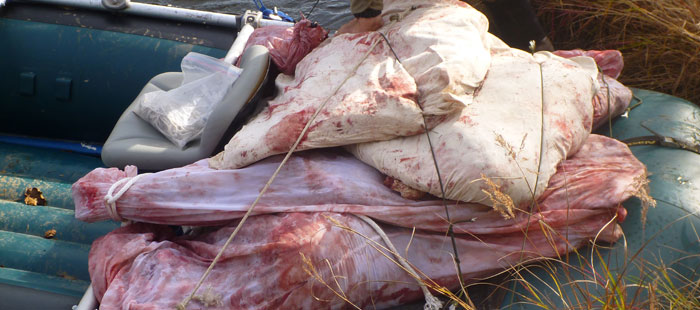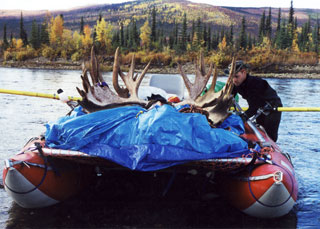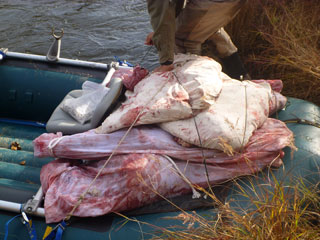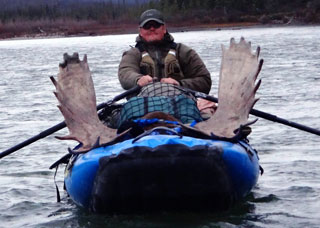Meat Care on the River
One of the keys to proper meat care is to keep the surface of the meat dry. This prevents spoilage due to surface bacterial contamination. As we saw in the section on general meat care, bacteria require a warm moist environment in order to reproduce. Removing the moisture (as much as possible) is essential to preventing spoilage of this kind.

Special Challenges
Keeping meat dry during transport on a powerboat or especially on an inflatable boat is a real challenge. The first issue is that space is limited. This can require boaters to stack meat bags atop each other. Wherever a meat bag contacts another one, moisture will develop. Additionally, if the meat is loaded where it is likely to be splashed with water from the lake or river, the drying process starts all over again. Finally, meat loaded on the floor of a boat will develop moisture at the point of contact. In all cases, this moisture is the enemy of good meat care. Notice in the photo above, that the two bags on top of the load appear dry, whereas the bags underneath are damp. This is because the bags on top are cotton, which breathes better than most synthetics, and it also absorbs moisture. The bags on the bottom are a non-breathable synthetic. The hunters on this trip had to pay special care to dry the bags at the end of every day or risk losing the meat to bacterial spoilage. In such cases, hunters should consider switching out for cotton bags. Read our game bag test for more details on this issue.
Loading the Boat
Avoid stacking meat bags on top of each other. In cases where there is no option, make time to stop periodically and reposition the damp bags to the top of the load so they can dry. Second, avoid loading meat directly on the floor of the boat. In the case of powerboats, use a framework of some kind, or even lay the meat atop cut brush to suspend it off the floor. This will allow some ventilation along the bottom of the load. With inflatable boats, meat loaded on the floor not only creates a moisture issue, it can be harmful to the boat. Meat is dense and heavy, and can push the floor down deeper into the water. If the boat drifts over a shallow obstacle, the impact on the bottom can rip the floor of the raft. Suspend your meat off the floor with the use of a vented mesh cargo platform. Most rafting equipment companies provide platforms designed to suspend loads in this fashion.
Rotate the Bags
If you're floating more than three or four hours, stop and re-stack your meat load. The bags on the bottom will be wet with condensation at the point of contact with other bags. Positioning them on top of your load gives them a chance to dry out again. Remember, one of the greatest challenges you face with meat care is keeping the surface of the meat dry.
Offloading
Finally, never leave meat on the boat overnight. Unload it and hang it if possible. If hanging is not possible, build a brush pile and load it atop the pile. This allows air to flow under the meat. If the bags are wet, pull them off and, if it's cold enough that flies are not flying, hang it overnight without the bags. If flies are an issue, change out the wet bags for dry ones, and hang the damp bags near a fire where they can dry overnight.
Notes on Boats
Proper meat care on a float hunt all starts with an awareness of the type of boat you're using, and the issues it presents for you.
Catarafts
Cats present the fewest negative issues when it comes to caring for the meat on the boat. First of all, most hunters use a cargo module system, which positions the meat several feet above the water where it is least likely to be splashed from the river. Second, cargo modules are almost always made of mesh material, which is ideal for good air circulation around your game bags. Finally, the cataraft offers the greatest amount of room to spread the bags out, which is critical to good ventilation. Meat bags piled on top of other meat bags create condensation at the point of contact and result in opportunities for bacterial contamination. In the photo at the left, an 18' AIRE Leopard cataraft is being loaded with the meat from two mature bull moose. The meat was loaded atop the mesh cargo platform, however due to the possibility of rain, the load was tarped. The tarp is draped loosely to facilitate airflow over the meat bags, which are spread out on the cargo platform for purposes of air circulation. The meat is then tied or strapped to the cargo platform, and the tarp secured separately. A cargo net may also be used in leiu of a cargo platform (as was done in this case), and a net can be secured over the load instead of ropes or straps. The net is actually easier because it takes less time to secure.
on the boat. First of all, most hunters use a cargo module system, which positions the meat several feet above the water where it is least likely to be splashed from the river. Second, cargo modules are almost always made of mesh material, which is ideal for good air circulation around your game bags. Finally, the cataraft offers the greatest amount of room to spread the bags out, which is critical to good ventilation. Meat bags piled on top of other meat bags create condensation at the point of contact and result in opportunities for bacterial contamination. In the photo at the left, an 18' AIRE Leopard cataraft is being loaded with the meat from two mature bull moose. The meat was loaded atop the mesh cargo platform, however due to the possibility of rain, the load was tarped. The tarp is draped loosely to facilitate airflow over the meat bags, which are spread out on the cargo platform for purposes of air circulation. The meat is then tied or strapped to the cargo platform, and the tarp secured separately. A cargo net may also be used in leiu of a cargo platform (as was done in this case), and a net can be secured over the load instead of ropes or straps. The net is actually easier because it takes less time to secure.
Round Boats
The biggest meat care issue concerning round boats are their limited cargo space.
 For example, the bow and stern sections on a 14' NRS Otter, seen in the photo here, are only 3' 8" wide. In this case, the neck and trim bag was loaded on top of the mesh cargo platform first, then the two hindquarters were loaded, one on each side, with the heavy end toward the seat bar. The two front quarters were loaded atop the hindquarters, but reversed and nested just inside the hindquarters, with the shank bones facing forward. Topping the entire load are the two large bags, each of which contains an entire rib slab. Finally, the load is being tied down with rope, to secure it in the event a bag starts to slide into the river. The load pictured in this photo, roughly 600 lbs, is all the meat from a large bull in the 55"-60" size class.
For example, the bow and stern sections on a 14' NRS Otter, seen in the photo here, are only 3' 8" wide. In this case, the neck and trim bag was loaded on top of the mesh cargo platform first, then the two hindquarters were loaded, one on each side, with the heavy end toward the seat bar. The two front quarters were loaded atop the hindquarters, but reversed and nested just inside the hindquarters, with the shank bones facing forward. Topping the entire load are the two large bags, each of which contains an entire rib slab. Finally, the load is being tied down with rope, to secure it in the event a bag starts to slide into the river. The load pictured in this photo, roughly 600 lbs, is all the meat from a large bull in the 55"-60" size class.
Because the meat is loaded low in the boat to help stabilize the boat in moving water (top-heavy boats are less stable), bags must be stacked atop one another. This results in condensation buildup in between game bags and may require more meat maintenance in camp to prevent bacterial spoilage. There is also a risk of splashes through the cargo net, especially if the boat is a self-bailer.
Inflatable Canoes, Kayaks and Hybrid Boats
These boats have even less interior space than conventional round boats, and require more finesse and creative thinking when packing heavy meat loads.
 Narrow cargo platforms are available for suspension just off the floor of your canoe, and should be used if at all possible. If the platform is not available, a conventional cargo net can be suspended to serve the same purpose. If the net is the same width as the ones used on round boats, leave half of it hanging off the side and fold it over the meat load once you're loaded. Cinch it down to the boat at this point, and you've used one net to both support the meat and secure it to the boat. The SOAR Pro Pioneer canoe to the left is loaded with most of the meat from a medium-sized bull, plus gear. The meat is loaded low on a cargo platform to keep the center of gravity low and lessen the chances of tipping, while stabilizing the boat. A cargo net was placed over the load to secure it.
Narrow cargo platforms are available for suspension just off the floor of your canoe, and should be used if at all possible. If the platform is not available, a conventional cargo net can be suspended to serve the same purpose. If the net is the same width as the ones used on round boats, leave half of it hanging off the side and fold it over the meat load once you're loaded. Cinch it down to the boat at this point, and you've used one net to both support the meat and secure it to the boat. The SOAR Pro Pioneer canoe to the left is loaded with most of the meat from a medium-sized bull, plus gear. The meat is loaded low on a cargo platform to keep the center of gravity low and lessen the chances of tipping, while stabilizing the boat. A cargo net was placed over the load to secure it.
Regardless of the type of boat used on your float hunt, in most cases it's best to stop at least once on long float days to re-arrange the meat bags, placing the damp ones on top so they can dry. This will help immensely in stalling the development of meat-spoiling bacteria.
Packrafts
Packrafts present significant challenges for transporting meat on the water. Extremely limited interior space, combined with limited load capacity, thinner fabric, and a low ride on the water create the worst of all worlds. If you're hunting out of a packraft, you can plan on the meat getting wet from splash over, contact condensation, and the gritty, muddy swill washing around the floor of your boat every day you're on the river. The limited load capacity combined with the thinner material the boats are made of create a shallow water dynamic that could result in a catastrophic tube failure if you find yourself dragging a heavily-laden packraft through the shallows much (which is exactly the kind of rivers most packrafters are looking for). Bring plenty of citric acid powder to treat the meat at the end of every float day, and bring a spare set of game bags, so you can swap out the wet ones when you hang the meat at night.
Bear Necessities
On any Alaska hunt, bears are always a concern! If a bear is nearby and if he manages to overcome his inhibitions even just a little, you could find yourself short a few meat bags or, worse yet, a chewed-up boat to go with it. This is especially problematic for rafters on float hunts, as bears love to bite rubber and plastic. That means that your meat-laden raft represents both dinner AND an evening's entertainment for the bruin family! The best defenses are as follows:
- Get the meat off the boat!
- Clean the boat with bleach!
- Use an electric fence!
The electric fence has proven time and again to be an excellent bear deterrent. One little zap and they're outta there. But there are some things you should pay attention to. First, get a good ground. This can be a challenge on rocky gravel bars, unless you can drive your grounding rod deeply into the riverbed where there is some water to provide a good ground. Second, ensure that nothing is touching the wire, or it could short out. And finally, be aware that a bear could inadvertently charge the fence if he's startled, possibly tearing it up or disconnecting something in the process. If your fence is going to be set up for a few days, inspect it every day for loose wires and damage.
Here's a checklist to ensure you have all the parts and pieces you need for your fence:
|
|
|
|
|
|
|
|
Set your electric fence up around your boat, set another one around your meat cache, and if you're hunting a higher-density bear area, consider setting one around your kitchen and sleeping areas. Bears will rarely bother you, but the fence helps ensure you mean business, and will help you sleep a little better at night.
Recommended Gear List
The following items are recommended by this site as a result of years of collective experience in the field working with Alaska game.
- Helle Nying knife (2 each)
- Havalon Piranta knife (1 each, with extra blades)
- E-Z Lap Model M diamond sharpener with sheath (1 each)
- Leatherman Wave multi-tool (1 each)
- ARS GR-17 folding saw, with extra blade (1 each)
- This email address is being protected from spambots. You need JavaScript enabled to view it., enough for intended harvest
- Estwing Camper’s Axe (1 each)
- Heavy-Duty Game Bags
- Citric Acid Powder
- UDAP electric fence kit for bear protection
- Flagging Tape
Additional Resources on Meat Care
- Alaska Field Care Handbook (two-part e-book by Michael Strahan)
- Field Care Handbook (book by Duncan Gilchrist)
- Float Hunting Alaska's Wild Rivers (book by Michael Strahan; contains extensive meat care section)
(ADFG Video)
